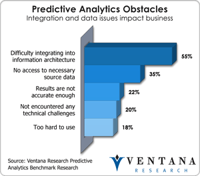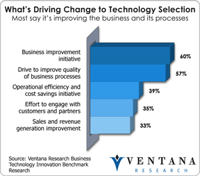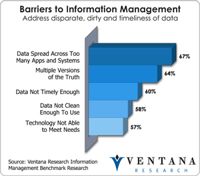I recently attended .conf2016, Splunk’s seventh annual user conference. Splunk created the market for analyzing machine data (shorthand for machine-generated data), which consists of log files and event data from various types of systems and devices. Our big data analytics benchmark research shows that these are two of the most common sources of big data that organizations analyze. This market has proven to be fertile ground for Splunk, growing steadily with revenues more than doubling over the...
Read More
Topics:
Machine Learning,
Splunk,
Analytics,
Machine data,
Operational Intelligence
Big data has become a big deal as the technology industry has invested tens of billions of dollars to create the next generation of databases and data processing. After the accompanying flood of new categories and marketing terminology from vendors, most in the IT community are now beginning to understand the potential of big data. Ventana Research thoroughly covered the evolving state of the big data and information optimization sector in 2014 and will continue this research in 2015 and...
Read More
Topics:
Big Data,
MapR,
Predictive Analytics,
Sales Performance,
SAP,
Supply Chain Performance,
Human Capital,
Marketing,
Mulesoft,
Paxata,
SnapLogic,
Splunk,
Customer Performance,
Operational Performance,
Business Analytics,
Business Intelligence,
Business Performance,
Cloud Computing,
Cloudera,
Financial Performance,
Hortonworks,
IBM,
Informatica,
Information Management,
Operational Intelligence,
Oracle,
Datawatch,
Dell Boomi,
Information Optimization,
Savi,
Sumo Logic,
Tamr,
Trifacta,
Strata+Hadoop
A few months ago, I wrote an article on the four pillars of big data analytics. One of those pillars is what is called discovery analytics or where visual analytics and data discovery combine together to meet the business and analyst needs. My colleague Mark Smith subsequently clarified the four types of discovery analytics: visual discovery, data discovery, information discovery and event discovery. Now I want to follow up with a discussion of three trends that our research has uncovered in...
Read More
Topics:
Datameer,
SAP,
Splunk,
Operational Performance,
Analytics,
Business Analytics,
Business Intelligence,
Business Performance,
Cloud Computing,
Customer & Contact Center,
IBM,
Information Applications,
Information Builders,
Operational Intelligence,
Oracle,
Data Discovery,
Information Discovery
Read More
Topics:
Big Data,
Splunk,
IT Performance,
Operational Performance,
Business Analytics,
Business Intelligence,
Business Performance,
Cloud Computing,
Customer & Contact Center,
Information Applications,
Information Management,
Machine data,
Operational Intelligence
Read More
Topics:
Sales Performance,
SAP,
Social Media,
Supply Chain Performance,
Peoplefluent,
Planview,
Research,
Splunk,
IT Performance,
Operational Performance,
Business Analytics,
Business Collaboration,
Business Intelligence,
Business Performance,
CIO,
Cloud Computing,
Customer & Contact Center,
Financial Performance,
IBM,
Information Applications,
Information Management,
Location Intelligence,
Operational Intelligence,
Workforce Performance,
Ceridian,
CFO,
CMO,
COO,
Datawatch,
Saba,
Technology
As I listened to the keynote address at, conf2012, the annual Splunk user conference, my initial impression was that the company was spreading itself too thin. The company highlighted four rather formidable areas of organizational focus: Enterprise 5.0, the company’s flagship data platform, which is now in beta; Development, which is support for building applications and integrating Splunk within the broader IT infrastructure; Content, the continued development of core applications and use...
Read More
Topics:
Big Data,
Splunk,
data fabric,
IT Performance,
Operational Performance,
Analytics,
Business Analytics,
Business Intelligence,
Business Performance,
Cloud Computing,
Customer & Contact Center,
Operational Intelligence,
Digital Technology
Recently my colleague Mark Smith wrote about Splunk and its latest technology supporting analytics for IT on machine data and providing operational intelligence. I wasn’t familiar with the company, which has focused on IT users and improving the performance of a company’s networks and IT systems. From a customer management perspective, these are of little interest unless they impact the customer experience; for example, if the website is down or the online banking system is unavailable. But in...
Read More
Topics:
Sales Performance,
Customer Experience,
Social CRM,
Splunk,
IT Performance,
Operational Performance,
Business Collaboration,
Business Intelligence,
Business Mobility,
Cloud Computing,
Customer & Contact Center,
Customer Service,
Information Applications,
Information Management,
Workforce Performance,
Call Center,
Contact Center,
CRM
Splunk recently entered the financial markets as a publicly traded company (NASDAQ: SPLK) and also entered a new phase in its corporate growth. Splunk combines the power of search and discovery with analytics on data generated by IT systems, that they call machine data, and provide insight for a new generation of operational intelligence that helps everyone in IT including the CIO determine the efficiency of its systems that support business. The company has built a platform that can index data...
Read More
Topics:
Big Data,
Social Media,
Supply Chain Performance,
Splunk,
IT Performance,
Operational Performance,
Business Analytics,
Business Collaboration,
Business Intelligence,
Business Mobility,
Business Performance,
Business Technology,
CIO,
Cloud Computing,
Customer & Contact Center,
Financial Performance,
Governance, Risk & Compliance (GRC),
Information Applications,
Information Management,
Information Technology,
IT Analytics,
Location Intelligence,
Machine data,
Operational Intelligence,
Strata+Hadoop















